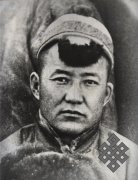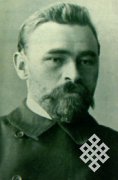Since December 2010, Tuva has been actively evaluation the question about the form of a planned monument to the founders of Tuvan statehood, which will be 90 years in 2011.
The government of Tuva has set up a curator committee, which is expected to evaluate all the proposals concerning the monument and to make a final decision. But to take personal responsibility for the final decision is not simple, because the opinions are strongly divided: during the process of evaluation, four distinct variants have separated - and the essence of the differences is very simple together or separate.
The event which took place 90 years ago in the small place of Sug-Bazhy, which later became the village Sug-Bazhy of Kaa-Khem district, really was of historical significance.
 On 13 - 16 of August, 1921, at the Pan-Tuvan central khural, a conference of all peoples living in the Uriangkhai region, Tuvan and Russian, the first Constitution of the free republic Tannu-Tuva Ulus, which later became the Tuvan People's Republic, was declared and accepted.
On 13 - 16 of August, 1921, at the Pan-Tuvan central khural, a conference of all peoples living in the Uriangkhai region, Tuvan and Russian, the first Constitution of the free republic Tannu-Tuva Ulus, which later became the Tuvan People's Republic, was declared and accepted.
This constitution was published in the collection "Constitutions of Tuva. 1921 - 1993.", which was published in 1999 in Kyzyl, in Tuvan book publishing house, in an issue of 1000 specimens. A huge work: the nine constitutions of Tuva from various years collected under a single red cover of this collection for the first time.
The chief collector of this material - the author of the Introduction and the editor of the collection is the candidate of historical sciences Vladimir Dubrovskiy. The scientific editor is the Doctor of historical sciences Mongush Kenin-Lopsan. Responsible editor - candidate of philological sciences Kaadyr-ool Bicheldei. General editor - Sholban Kara-ool. All these names are well-known and famous, each in its own way.
The first constitution published for the first time for mass study and analysis offers much opportunity for analysis to an inquiring mind.
The first paragraph of the constitution states: "Republic Tannu-Tuva Ulus is a free government of the nation Tannu Tuva, independent of anybody in its internal matters. In its international relationships, the republic acts under the protectorate of the Soviet Russia."
Already back then, the orientation was determined, which later determined the entire further course of development of the country torn by contradictions - Russia.
The second paragraph defines the equality of all the citizens of Tannu-Tuva before the law. A huge achievement - right from a feudal system to a society of democratic norms.
 But the most curious, in my opinion, is the seventh paragraph, which deals with torture in Tuva. Literally it is formulated like this: "Punishments by canes, restraint in stocks and torture during interrogation is to be substituted by fines and forced labor."
But the most curious, in my opinion, is the seventh paragraph, which deals with torture in Tuva. Literally it is formulated like this: "Punishments by canes, restraint in stocks and torture during interrogation is to be substituted by fines and forced labor."
The archival documents bear evidence: this pint w3as the cause of the greatest argument at the conference. The Russian delegation led by Innokentiy Safianov insisted that it was not acceptable for a civilized state to preserve the use of torture in law enforcement. The Tuvan delegation led by the chairman of the conference - Buyan-Badyrgy Mongush - - according to historical tradition - doubted that interrogations can be carried out mercifully, and considered this one point of the constitution unacceptable.
However, even in this matter so complicated for its time, the participants in the conference in the end could understand each other. On 15 August 1921 - at the third meeting - Buyan- Badyrgy announced, that after having listened to the explanations and understanding them, all the participants in the conference agree with the Russian delegation: corporal punishments and torture will be discontinued.
All the paragraphs of the first Constitution were accepted unanimously.
It is not even necessary to have the scholarly title of a candidate or Doctor of sciences to read and analyze the historical documents and to understand: Tuvan statehood was created jointly.
It was hard, it was a torment, but they did it together. And the monument to it, since this idea has come up, has to be a joint one.
It is my firm opinion, which I expressed already nine years ago in the #44 of Center of Asia" on October 25, 2002, as epilogue to the essay by Tatiana Vereshchagina "The last noyon of Daa-Kozhuun and his descendants". This essay by Vereshchagina about Buyan-Badyrgy and her essay about Safianov "Ekkendei" later became a part of the third volume of the book "People of the Center of Asia", published by the editors of the journal "Center of Asia" in 2006.
So, my position back then went like this:
"In Kyzyl, on the crossroad - opposite the sewing factory, a little bit oblique from the tele-center, there is a structure forgotten by all. On the cement plinth, there is a rectangular stone. At its foot, there are shards of a broken bottle.
There is an inscription on the stone: "Here a monument to the noyon Buyan-Badyrgy will be built - to the founder of Tuvan state."
They built it eight years ago, on a wave of growing self-esteem. But the wave dropped off, and history as well as those who moved it forward seemed unnecessary.
For how long will this symbol of forgotten history stand here, abstractly announcing that someday something will be here? I would think that the government of Tuva should have declared an art contest for the best project for the monument, and to allocate money for erecting it, and use donations from the citizens who are not indifferent to their own history.
I envision the monument like this: Buyan Badyrgy Mongush and Innokentiy Safianov side by side. Two exceptional people born from different cultures, who could successfully overcome all controversies, understand each other, and to join in creating one common, great and important feat.
They never received recognition during their lifetime. One of them was rewarded with a bullet, the other was exiled from Tuva. So let them stand here together, just like they stood together back then at the conference in Sug-Bazhy, which accepted the first constitution of Tuva, and declared the rights of its citizens - all of them, regardless of nationality and faith.
Such a monument is not simply a homage to the past - it is also a symbol of the future. And Tuva needs it very much."
And my position on this subject has not changed
Currently there are four variants of opinions on the appearance of this monument.
The first variant is the original one: to build a monument to Buyan-Badyrgy Mongush alone.
The second is a long-term variant - to build a separate monument to Buyan-Badyrgy in 2011, and later, sometime in foreseeable future, another one to Safianov.
The third one is a compromise: build a monument to Buyan-Badyrgy, and show the friendship of nations on the pedestal under his feet with modest symbolic not very noticeable bas-reliefs of the "most prominent participants of the Pan-Tuvan central Khural", including Safianov.
The fourth variant is a common monument to Mongush Buyan-Badyrgy and Innokentiy Safianov. Without evasions - a simple one, straightforward, comprehensible to everybody right away - even to those who do not know much about history. As a symbol of mutual understanding of the nations, striving not to the past torn by contradictions, but to the future.
Simply side by side, simply - together.

